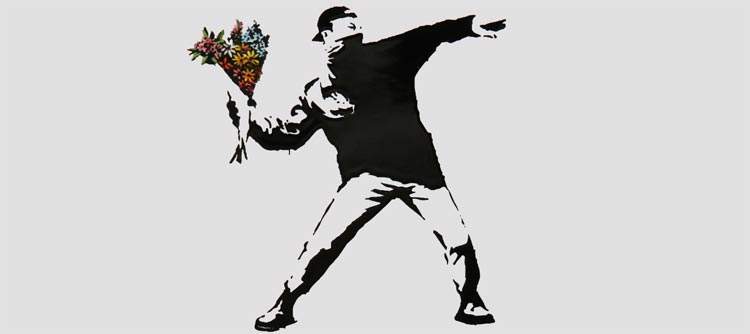The “Banksy” trademark may be at risk after the anonymous British street artist lost a legal battle over the use of the image of one of his works. The case, which began two years ago, pitted Banksy against a small British company, Full Colour Black, which had used the famous Flower Thrower image for a greeting card to be offered for sale (the company’s business is precisely the sale of greeting cards).
The verdict came on September 14 after two years of legal battles. In short, the European Union Intellectual Property Office (EUIPO) ruled that Banksy cannot claim rights to the image because he has always chosen to remain anonymous, and consequently cannot be recognized as the rightful owner of the work. This is a subtle difference between trademark and copyright: a trademark can be registered by anyone, while on the other hand, in order to be able to exercise one’s copyright, it is necessary for the author to declare himself the owner of the work (and therefore, since Banksy is anonymous, theoretically anyone could claim his work). According to the EUIPO’s argument, Banksy, in order to circumvent the copyright laws that would have required him to come out of anonymity, had the Pest Control Office (the company that handles his relationships) register the trademark of his work to protect his image, but he never exploited the trademark to make commercial use of it (that’s what registration would in fact be for).
Banksy “cannot be identified as the unquestionable owner of the work,” the EUIPO let them know, “because his identity is concealed, and as a result it cannot be established without challenge that the artist has copyright in a work of street art.” Moreover, the EUIPO judges further noted, “Banksy chose to remain anonymous and paint graffiti on the property of third parties without their permission, instead of painting it on canvases or on his own property.” The judges went on to point out that the work’s first appearance (on a wall in Jerusalem) was in 2005, but as early as the following year, in 2006, the work had appeared on the cover of a Banksy book, Wall and Piece, in which, the guides note, the artist “celebrates in positive terms the virtue of disobedience to copyright and trademark laws.”
The Flower Thrower had been registered as a trademark in 2014 by the Pest Control Office. However, in March 2019, Full Colour Black had sought to have the trademark formally cancelled, arguing that it had been registered in bad faith (i.e., not for commercial use). In response, Banksy, last October, had opened a store, called “Gross Domestic Products”: the street artist stated at the time that opening a store because of an ongoing legal battle was “probably the least poetic reason to make art,” adding that “a greeting card company is contesting the trademark based on my art in an attempt to take custody of my name so that they can legally sell their fake Banksy-branded merchandise.”
This move, however, according to the EUIPO, would have aggravated the artist’s position. Indeed, it appears that Banksy did not sell any items with the Flower Thrower image from 2014 until Full Colour Black used it for its postcards. Indeed, European law provides that the owner of an earlier trademark cannot challenge those who use it if the presence of the mark has been tolerated for five consecutive years. The fact that Banksy therefore only opened his store in 2019, according to the EUIPO makes it “clear that Banksy had no intention” to use the mark when Pest Control Limited registered it in 2014, and that the goods he began selling in 2019 were created and sold only as an attempt not to lose the right to use the mark. “Its intention,” the EUIPO explains, “was not to use the trademark to offer goods for sale and to carve out a niche in the market, but only to circumvent the law. These actions are contrary to honest practices.”
And now, in fact, anyone could use its images, as attorney Aaron Wood explained to the BBC. Wood, who represents Full Colour Black, let it be known that “Banksy’s problem lies in the fact that to enforce his copyright he would have to come out of the shadows. He would have to come out and say ’here I am, I’m the one who created the work.’ And to do that he would lose his nonimage. So he won’t do that.” On the trademark issue, Wood says that “anyone can register one, so Banksy’s company registered the trademark of his work. A trademark can last forever; it’s a perpetual monopoly. In contrast, copyright lasts only a certain period of time, and to exploit it Banksy would have to come out of anonymity, whereas by relying on the trademark he can remain anonymous and use it even longer. But in our opinion this is not the right way to approach this issue.”
Full Colour Black has now challenged the trademarks of six more of Banksy’s works, and will likely move forward with more of his work as well. “Banksy’s entire trademark portfolio is now at risk,” Wood concluded.
Pictured is the Flower Thrower.
 |
| Banksy loses legal battle over trademark: artist allegedly acted in bad faith |
Warning: the translation into English of the original Italian article was created using automatic tools. We undertake to review all articles, but we do not guarantee the total absence of inaccuracies in the translation due to the program. You can find the original by clicking on the ITA button. If you find any mistake,please contact us.